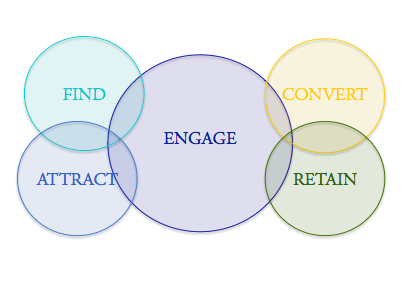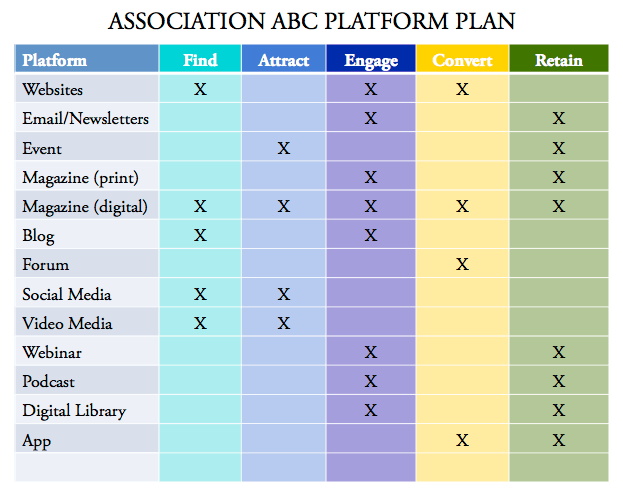3 Principles to Multi-Platform Publishing

Written by Matt Berringer
May 7, 2015
We are living in a content junkie’s dream. Anywhere he or she goes, there is instant access to all kinds of content, summoned with a quick search and tap of the finger. At this point, we get irritated when we can’t have access to content and feel scandalized when we feel it’s being withheld. (You want me to pay how much to access the internet on this plane?)
What is Digital Darwinism?
While this means people are more connected than ever before, it has had a negative effect for companies that can’t keep up with the content demand. Brian Solis describes “Digital Darwinism” as the phenomenon in which technology and society evolve faster than an organization can adapt.
This concept has claimed entire industries as they struggle to keep up with the gadgets and platforms that seem to develop overnight. Yet society embraces the changes: digitized communication is rapidly becoming the main avenue for consumer experiences.
As a result, multi-platform publishing has evolved from a buzzword to business necessity. The idea is to get similar or related content onto multiple channels in order to reach and appeal to more people. The reasons for it are many, but here are a few:

Unfortunately, there isn’t an adequate universal strategy for tackling multi-platform publishing.
What is Cross-Platform Marketing?
Cross-platform marketing includes campaigns and strategies that extend across multiple channels, from digital to print to social media.
How to Market with Cross-Platform Content Strategy
Often, publishers are left to develop strategies based on instinct. Some have gotten creative in their approach: Some publishers prefer the “chunk” method, or starting with large pieces of content and distributing smaller pieces of it across various platforms.
Other group platforms by their expected sales funnel capabilities and deliver targeted content according to sales stages. Still others syndicate everything they have to every platform they can, while others optimize for two or three platforms to keep it all manageable.
Associations have it especially hard. They need to bring to life via digital channels the same sense of community one gets being a part of a physical organization, and they need to do it in a sustainable way. For that to happen, they need to think of multi-platform publishing in terms of contributing to both the member experience and benefits to the Association. This mutual benefit can be summed up in five basic goals: to find, attract, engage, convert or retain readers/members.

For the purpose of this article, the goals are defined as the following:
- Find: This goal is two-fold. First, it helps you find your audience on multiple channels, but is also increases your “findability” by boosting your SEO with targeted content.
- Attract: Multiple platforms gives you the opportunity to promote your content in ways your audience prefers. Your content should be visually appealing, prompts an easy click or share, and focuses on bringing new or lost readers to your brand for more.
- Engage: Once attracted to you, this content inspires deeper interaction with your organization. It provides consistent content on a regularly scheduled basis, focuses on education and promotes further action by the reader. This can be targeted for readers before and after they convert.
- Convert: This is most likely content and platform working together to enable a reader to become a member or follower. (Conversion “rules” are set by you.)
- Retain: This content is focused on reaffirming members as being an integral part of the group. While keeping readers engaged, it also strives to make members feel heard and a part of the brand. It also works to keep members wanting to be members.
What are the goals of a digital platform? A website platform achieves three goals: find, engage and convert. The content posted there affects your search rank, but it also makes sure you’re on the #1 digital platform, where everyone else is. The content is engaging, driving readers to dig deeper into your brand, your content, and your mission. This is likely the most popular platform for converting members digitally via online forms.
Why is a website not a good platform for retention? Because that would assume members actively return to your site for fresh content. What is more likely is a push from another platform prompts them to return. If retention is achieved via your website, it’s most likely via passive benefit versus an active goal.
In this instance, the website achieves three out of the five goals, which means other platforms need to fill in the gaps. This leads to the first principle of multi-platform publishing.
PRINCIPLE 1: Different platforms are differently suited for different goals
Part of the reasons why multiplatform publishing is necessary is because each platform fills a different need for the end-user, whether that is to catch up on the daily news, to crowd-source solutions to a problem, research an area of interest, or perhaps stay amused while waiting in a long line. To tap into that network of people, you have to be there and offering the kinds of content they are looking for while on that platform.
In light of this, you should take stock of which platforms you are currently on, as well as start asking which platforms your target audience prefers. You might be surprised. The New Yorker, for instance, is famous for its artwork, yet they successfully sell a 12-month audio of their magazine. It’s valuable, therefore, to take a look at the metrics available for various platforms, including your own.
Then start asking if the platforms you currently use adequately cover all five goals. Are there gaps in your availability to your target audience? The following chart is an example of one association’s approach to this task. They used a chart to map out each content platform they used and what goal they hoped would be met by the content posted to that platform:

PRINCIPLE 2: Focus on the total experience, not the individual click
Members will look to interact with you on multiple channels throughout their life cycle with you, and it is to your benefit to be organized around that experience rather than too focused on individual channels. One channel needs to feed the other, and every content campaign needs to transcend every channel.
To put it into more practical terms, consider how much time you spend on one platform: email. You might obsess over getting readers to open and click on an email, only to send them to a generic landing page on your website. One platform did feed another, but because you deal with each platform individually all your focus went into the email and didn’t consider how the two platforms interacted. The member experience is lost in that case.
Or consider the experience if your email is built in responsive design, but your destination landing page is not. With over 45% of all marketing emails being read on mobile devices, part of being platform aware is recognizing as a member transitions from one platform to another, they could be on a mobile device. You might “win” by getting the click, but you’d “lose” when a frustrated member bounces off with the next platform interaction.

PRINCIPLE 3: Each platform is a learning opportunity
One of the many benefits to multiplatform publishing is the increased insight you get into what your audience finds valuable. You can see per platform what your audience clicks on, shares, or spends time reading. By watching the analytics across platforms you’ll be able to see which overarching campaigns were a hit, and which were misses. You’ll also have better ability to identify the strong influencers in your midst and can use that to help promote ideas or events to your membership.
As digital technology continues to evolve, so will your member experience. Even outside of technology, things change: your members get new jobs, new interests, new friends, new beliefs, new devices and new challenges. This will shape how they choose to interact in the digital space, which will contribute to how you need to adapt based on these changes. Start with understanding where your organization is currently in the marketplace, and where your audience is. Then make sure your campaign, branding and messaging are cohesive, transcending individual platforms into a fully functional digital strategy. Lastly, take advantage of the increased metrics digital campaigns give you, and prepare to adapt again.
Multi-platform publishing isn’t truly summarized in three principles, though it is a start. You’ll also need to consider things such as the role of digital devices, content marketing, and identifying proper performance indicators for each platform. While the industry is still adapting to the rapid technological changes, take advantage of opportunities to gather with others to learn from their experience and from industry research.